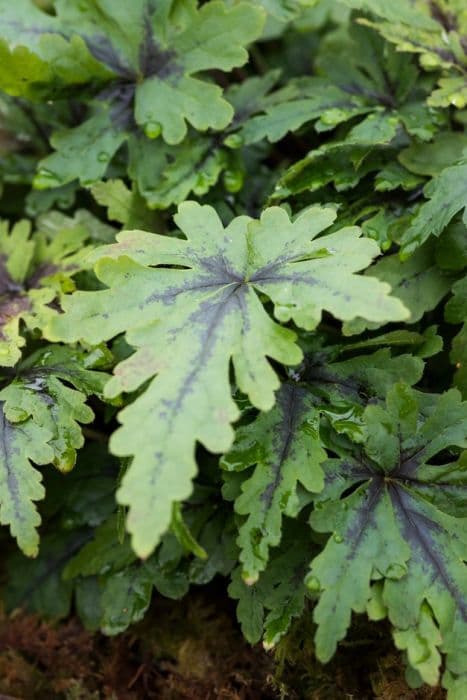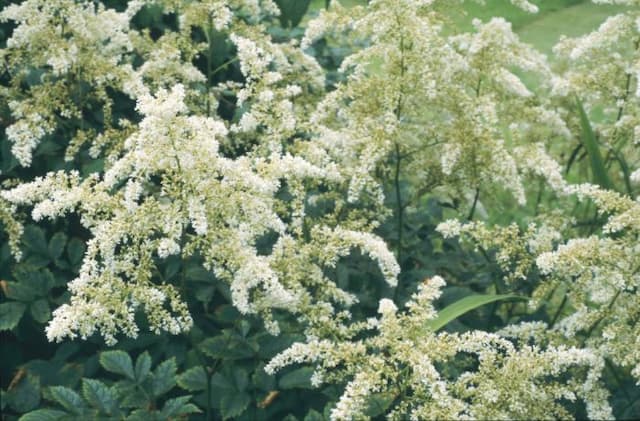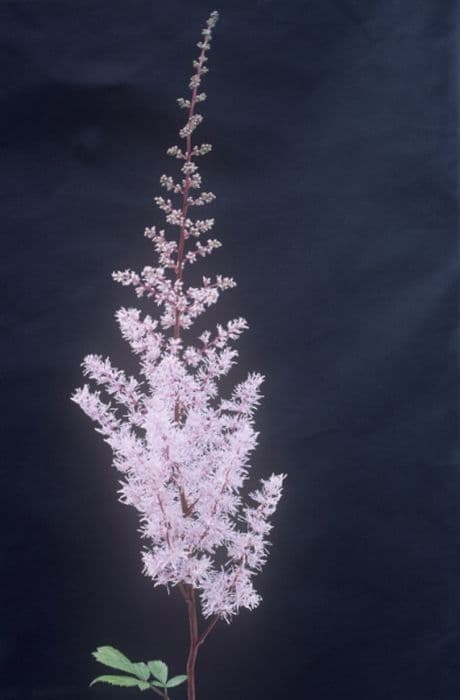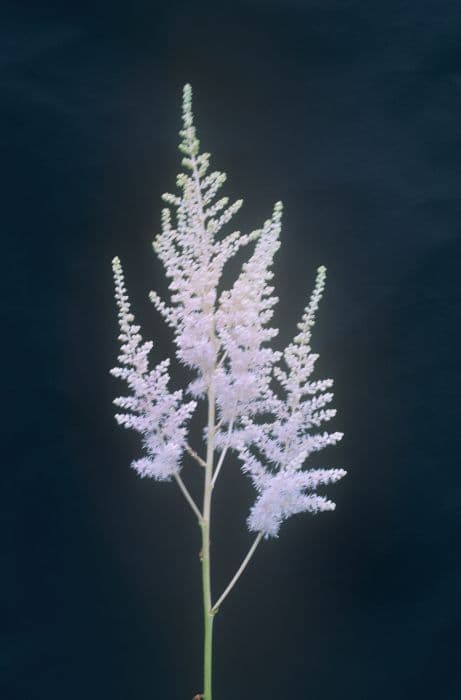Foam flower 'Angel Wings' Tiarella Angel Wings = 'Gowing' (PBR) (Fox Series)

ABOUT
[Angel Wings] is a small, neat, hybrid perennial that has very dissected, lobed and sometimes tiered, mid-green leaves with deep crimson central markings. Flower panicles with deep pink flower buds fade as they open to pale-pink and ultimately frothy white wands over a long period from spring to summer
About this plant
 Names
NamesFamily
Saxifragaceae
Synonyms
Foamflower, Angel Wings Foamflower
Common names
Tiarella 'Gowing'.
 Characteristics
CharacteristicsLife cycle
Perennials
Foliage type
Deciduous
Color of leaves
Green
Flower color
White
Height
1 feet (0.3 meters)
Spread
2 feet (0.6 meters)
Plant type
Herb
Hardiness zones
4
Native area
North America
Benefits
 General Benefits
General Benefits- Shade Tolerance: Tiarella, commonly known as Foamflower, thrives in shaded areas where other plants might struggle to grow.
- Attractive Foliage: The 'Gowing' variety has unique and ornamental leaves that add visual interest to gardens.
- Ground Cover: With its spreading habit, it serves as an excellent ground cover to prevent soil erosion and suppress weeds.
- Low Maintenance: Foamflower is known for being low maintenance, requiring minimal care once established.
- Drought Resistance: Once established, this plant can tolerate periods of dryness, making it suitable for drier climates or water-conserving landscapes.
- Seasonal Interest: It provides year-round interest with its foliage and blooms attractive flowers in the spring or early summer.
- Pest and Disease Resistance: Foamflower generally resists common garden pests and diseases, making it an easy choice for gardeners looking to avoid chemical treatments.
- Wildlife Attraction: The flowers of Foamflower attract pollinators such as bees and butterflies, supporting local ecosystems.
- Non-Invasive: Unlike some ground covers, Foamflower is non-invasive, meaning it won’t take over your garden or naturalize in unintended areas.
- Cold Hardy: Foamflower is cold hardy and can withstand frost, making it suitable for gardens in cooler climates.
 Medical Properties
Medical PropertiesThis plant is not used for medical purposes.
 Air-purifying Qualities
Air-purifying QualitiesThis plant is not specifically known for air purifying qualities.
 Other Uses
Other Uses- Container Gardens: Tiarella can be used to add texture and foliage interest in container garden arrangements, particularly in shady spots where other plants might not thrive.
- Ground Cover: Due to its dense and spreading habit, Tiarella is effective as a ground cover, reducing the need for mulching and weed control.
- Fairy Gardens: With delicate foliage and soft, feather-like flowers, Tiarella 'Angel Wings' makes an enchanting addition to whimsical fairy garden designs.
- Living Mulch: Planted densely, Tiarella can act as a living mulch, providing the benefits of mulch while being aesthetically pleasing and supporting biodiversity.
- Edge Accents: Because of its mounding form, Tiarella can be planted along the edges of pathways and borders for a soft, natural fringe that requires little maintenance.
- Naturalizing Woodland Areas: This plant is ideal for naturalizing in woodland gardens, contributing to a forest-like, untamed landscape aesthetic.
- Erosion Control: The spreading and dense root system of Tiarella helps to prevent soil erosion on slopes and banks in shaded garden locations.
- Cut Foliage: While not a traditional cut flower, Tiarella leaves can be used in floral arrangements for their interesting texture and color.
- Seasonal Interest: Tiarella provides visual interest throughout the seasons, from spring blossoms to autumn when foliage often turns into attractive bronze or reddish tones.
- Butterfly and Pollinator Garden: Tiarella flowers attract butterflies and other pollinators, making them suitable for inclusion in pollinator-friendly gardens.
Interesting Facts
 Feng Shui
Feng ShuiThe Tiarella is not used in Feng Shui practice.
 Zodiac Sign Compitability
Zodiac Sign CompitabilityThe Tiarella is not used in astrology practice.
 Plant Symbolism
Plant Symbolism- Endurance: Tiarella, also known as Foamflower, often symbolizes endurance due to its ability to thrive in woodland settings and its resilient nature.
- Feminine Energy: The soft, delicate flowers of Tiarella may be associated with feminine energy and characteristics such as grace and gentleness.
- Purity: The white flowers of some Tiarella varieties may convey purity and innocence, as white is commonly associated with these traits.
- Protection: Tiarella's dense foliage can signify protection, as the plant can provide ground cover and shelter for smaller woodland inhabitants.
 Water
WaterFoam flowers should be watered deeply enough to soak the soil around their roots, generally about once a week depending on the soil moisture levels and climate. They prefer consistently moist soil, so regular watering is crucial, particularly during dry spells. In hotter seasons or in dry conditions, water at least 1 gallon per week to ensure adequate moisture, but in cooler or wetter conditions, you may need to water less frequently. Adjust the amount of water based on rainfall and the specific needs of your plant, checking the soil before watering to avoid over-saturation.
 Light
LightFoam flowers thrive best in partial to full shade settings where they are shielded from the intense midday sun. The perfect spot for a foam flower is in dappled sunlight beneath open-branched trees or in a shaded garden bed. They can tolerate morning sunlight but should be protected from strong afternoon rays to prevent leaf scorch.
 Temperature
TemperatureFoam flowers are cold-hardy and prefer temperate climates with temperatures ranging between 60°F and 75°F. They can tolerate a minimum temperature of around -20°F, but it is suggested that they be protected if temperatures consistently drop below this during winter. During the summer months, ensure they are not exposed to prolonged temperatures over 85°F which could stress the plant.
 Pruning
PruningFoam flowers require minimal pruning primarily to remove any spent flowers or damaged foliage, which encourages new growth and maintains the plant’s attractive appearance. The best time for pruning is immediately after blooming has finished. Occasionally trimming the plant can also promote a bushier growth habit.
 Cleaning
CleaningAs needed
 Soil
SoilFoamflower prefers moist, well-draining soil rich in organic matter. A mix of peat, loam, and perlite or vermiculite can create an ideal environment. The best soil pH for it ranges from slightly acidic to neutral (pH 5.5 to 7).
 Repotting
RepottingFoamflowers typically do not require frequent repotting and can thrive in the same container for several years. Evaluate every two to three years and repot if it has outgrown its current pot.
 Humidity & Misting
Humidity & MistingFoamflower thrives in moderate to high humidity levels, ideally between 50-70%. Ensure good air circulation to prevent diseases.
 Suitable locations
Suitable locationsIndoor
Place Foamflower in bright, indirect light and keep soil moist.
Outdoor
Plant in part-shade, ensure moist soil, and protect from strong sun.
Hardiness zone
4-9 USDA
 Life cycle
Life cycleThe Tiarella 'Angel Wings', commonly known as Foamflower, starts its life as a seed, which upon germination in favorable conditions of moist, well-draining soil and dappled shade, sprouts into a small seedling. The seedling grows into a clump-forming perennial, developing heart-shaped leaves that are deeply lobed and often marked with striking patterns. Through spring to early summer, it produces erect, feathery plumes of tiny, star-shaped flowers, attracting pollinators. After flowering, the plant enters a phase of vegetative growth where foliage may spread and may also produce stolons or runners to propagate itself vegetatively. As autumn approaches, growth slows and the plant may die back, with the foliage sometimes providing autumn color before entering dormancy for the winter. With the return of spring warmth, the Tiarella 'Angel Wings' breaks dormancy and resumes growth, completing its yearly cycle.
 Propogation
PropogationPropogation time
Spring to Summer
The Tiarella 'Angel Wings', commonly known as the Foamflower, is most successfully propagated through division, which should ideally be carried out in the spring or fall. This involves gently separating a mature plant into multiple sections, making sure that each new section has a portion of the root system and several shoots. The divisions are then planted in moist, well-drained soil and shaded from intense sun, ensuring that each new plant has ample space to establish. Care should be taken to water the divisions regularly until they are fully established, encouraging a deep and healthy root system. This method allows for quick and effective multiplication of Foamflower plants while maintaining the parent plant's characteristics.









